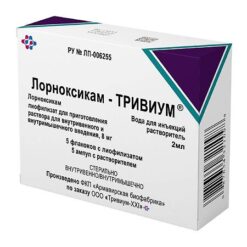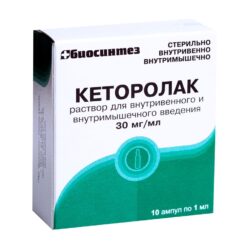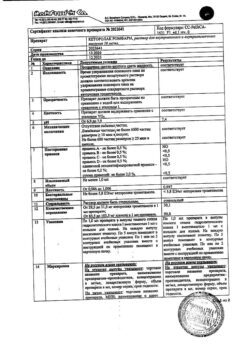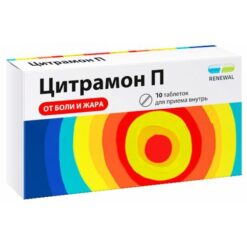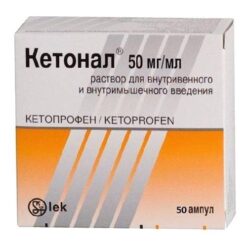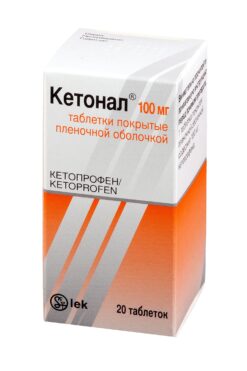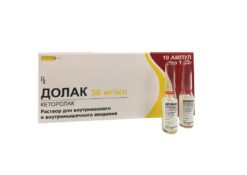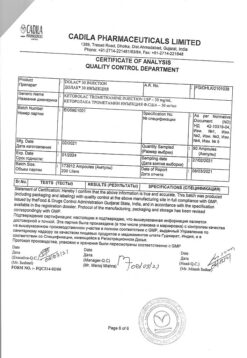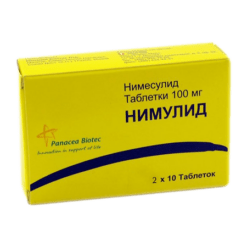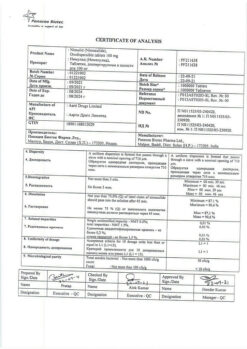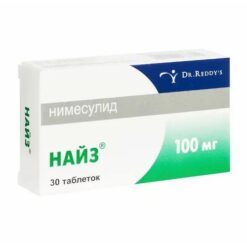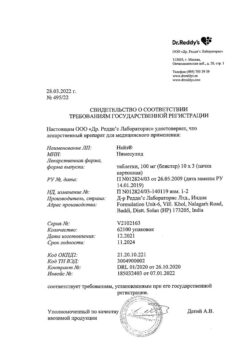No products in the cart.
Lornoxicam, lyophilizate 8 mg 5 pcs
€1.00
Out of stock
(E-mail when Stock is available)
Description
Pharmacodynamics
Lornoxicam is a non-steroidal anti-inflammatory agent, has pronounced analgesic and anti-inflammatory effect, belongs to the class of oxycams.
The mechanism of action is the inhibition of prostaglandin synthesis (inhibition of cyclooxygenase enzyme), leading to suppression of inflammation.
Lornoxicam has no effect on key body parameters: body temperature, heart rate (HR), blood pressure (BP), electrocardiogram (ECG), spirometry.
The analgesic effect of lornoxicam is not associated with narcotic action.
Lornoxicam does not have an opiate-like effect on the central nervous system (CNS). Unlike narcotic analgesics it does not suppress respiration and does not cause drug addiction.
Due to the local irritating effect on the gastrointestinal tract (GIT) and systemic ulcerogenic effect associated with inhibition of prostaglandin synthesis, GIT complications are common undesirable effects during treatment with non-steroidal anti-inflammatory drugs.
Pharmokinetics
Absorption
Maximum concentration (Cmax) of lornoxicam in blood plasma during intramuscular (v/m) injection is reached after about 0.4 hours. Absolute bioavailability (calculated by AUC – area under the curve “concentration-time”) after intramuscular administration is 97%.
Distribution
Lornoxicam is found in plasma unchanged and as a hydroxylated metabolite. The degree of binding of lornoxicam with plasma proteins is about 99% and does not depend on the concentration. Biotransformation Lornoxicam is largely metabolized in the liver, mainly through hydroxylation to inactive 5-hydroxylornoxicam.
Biotransformation of lornoxicam is performed via CYP2C9 isoenzyme. Due to the polymorphism of the gene encoding this enzyme, there are people with slow and fast metabolism of the drug, which can lead to a significant increase in plasma levels of lornoxicam in those with slow metabolism. Hydroxylated metabolite has no pharmacological activity. Lornoxicam is completely metabolized: about 2/3 of the drug is excreted by the liver, and 1/3 – by the kidneys as an inactive metabolite.
Excretion
Half-life (T1/2) of lornoxicam on average is 3 to 4 hours. The drug clearance is decreased by 30-40 % in elderly patients (over 65 years). No significant changes in lornoxicam kinetics are observed in patients with hepatic or renal dysfunction, except for cumulation in patients with chronic liver disease after 7 days of treatment at a daily dose of 12 mg or 16 mg.
Indications
Indications
Short-term treatment of mild to moderate acute pain. Symptomatic treatment of pain and inflammation associated with osteoarthritis.
Symptomatic treatment of pain and inflammation associated with rheumatoid arthritis.
Pharmacological effect
Pharmacological effect
Pharmacodynamics
Lornoxicam is a non-steroidal anti-inflammatory drug, has a pronounced analgesic and anti-inflammatory effect, belongs to the class of oxicams.
The mechanism of action is based on suppression of prostaglandin synthesis (inhibition of the enzyme cyclooxygenase), leading to suppression of inflammation.
Lornoxicam does not affect the main indicators of the body’s condition: body temperature, heart rate (HR), blood pressure (BP), electrocardiogram (ECG) data, spirometry.
The analgesic effect of lornoxicam is not associated with narcotic effects.
The drug Lornoxicam does not have an opiate-like effect on the central nervous system (CNS) and, unlike narcotic analgesics, does not depress respiration and does not cause drug dependence.
Due to the presence of a local irritant effect on the gastrointestinal tract (GIT) and a systemic ulcerogenic effect associated with the suppression of prostaglandin synthesis, gastrointestinal complications are common undesirable effects during treatment with non-steroidal anti-inflammatory drugs.
Pharmakinetics
Suction
The maximum concentration (Cmax) of lornoxicam in blood plasma after intramuscular (IM) administration is reached after approximately 0.4 hours. Absolute bioavailability (calculated by AUC – area under the concentration-time curve) after intramuscular administration is 97%.
Distribution
Lornoxicam is found in blood plasma unchanged and as a hydroxylated metabolite. The degree of binding of lornoxicam to plasma proteins is about 99% and does not depend on concentration. Biotransformation Lornoxicam is extensively metabolized in the liver, mainly through hydroxylation to inactive 5-hydroxylornoxicam.
Biotransformation of lornoxicam is carried out through the CYP2C9 isoenzyme. Due to polymorphisms in the gene encoding this enzyme, there are slow and rapid metabolizers of the drug, which can lead to a significant increase in plasma levels of lornoxicam in slow metabolizers. The hydroxylated metabolite has no pharmacological activity. Lornoxicam is completely metabolized: approximately 2/3 of the drug is excreted by the liver, and 1/3 by the kidneys in the form of an inactive metabolite.
Removal
The half-life (T1/2) of lornoxicam averages 3 to 4 hours. In elderly people (over 65 years of age), drug clearance is reduced by 30-40%. In patients with impaired liver or kidney function, no significant changes in the kinetics of lornoxicam are observed, with the exception of accumulation in patients with chronic liver disease after 7 days of treatment at a daily dose of 12 mg or 16 mg.
Special instructions
Special instructions
The drug should not be used simultaneously with other NSAIDs.
The risk of gastrointestinal bleeding, ulceration, or GI perforation increases with increasing doses of NSAIDs in patients with a history of gastric ulcer, especially if it is accompanied by complications such as bleeding or perforation in the elderly.
Such patients should begin treatment with the lowest possible dose of the drug.
In such patients, as well as in patients who require concomitant use of low-dose acetylsalicylic acid or other drugs that may increase the risk of adverse gastrointestinal events, concomitant administration of drugs that have a protective effect (for example, misoprostol or proton pump inhibitors) is indicated.
Regular monitoring is recommended. If signs of liver damage appear (itching, yellowing of the skin, nausea, vomiting, abdominal pain, dark urine, increased levels of “liver transaminases”), you should stop taking the drug and consult your doctor.
The drug can change the properties of platelets, but does not replace the preventive effect of acetylsalicylic acid in cardiovascular diseases.
Impact on the ability to drive vehicles and machinery
Patients who experience dizziness and/or drowsiness during treatment with lornoxicam should refrain from driving or operating machinery.
Active ingredient
Active ingredient
Lornoxicam
Composition
Composition
1 bottle contains:
Active ingredient:
lornoxicam – 8.0 mg
Excipients:
mannitol (mannitol) – 100.0 mg,
trometamol – 12.0 mg,
disodium edetate (disodium salt of ethylenediaminetetraacetic acid dihydrate) – 0.2 mg,
sodium hydroxide – up to pH 8.0-9.5.
Contraindications
Contraindications
Hypersensitivity to lornoxicam or any of the excipients;
complete or incomplete combination of bronchial asthma, recurrent polyposis of the nose or paranasal sinuses, rhinitis, angioedema,
urticaria and intolerance to acetylsalicylic acid and other NSAIDs (including a history);
thrombocytopenia;
hemorrhagic diathesis or bleeding disorders, as well as those who have undergone operations associated with the risk of bleeding or incomplete hemostasis;
period after coronary artery bypass surgery;
decompensated heart failure;
pink and ulcerative changes in the mucous membrane of the stomach or duodenum, active gastrointestinal bleeding; cerebrovascular or other bleeding;
history of gastrointestinal bleeding or ulcer perforation associated with NSAID use;
active peptic ulcer or history of recurrent peptic ulcer;
inflammatory bowel diseases (Crohn’s disease, ulcerative colitis) in the acute phase;
severe liver failure;
severe renal failure (serum creatinine level more than 700 µmol/l), progressive kidney disease, confirmed hyperkalemia;
pregnancy and breastfeeding period;
patients under 18 years of age (due to insufficient clinical experience).
With caution
For the following disorders, Lornoxicam should be prescribed only after a careful assessment of the expected benefits of therapy and the possible risks:
Impaired renal function: mild (serum creatinine 150-300 µmol/l) and moderate (serum creatinine 300-700 µmol/l), since the maintenance of renal blood flow depends on the level of renal prostaglandins. Lornoxicam should be discontinued if renal function deteriorates during treatment.
Monitoring of renal function should be carried out in patients who have undergone major surgery, patients with heart failure receiving diuretics, and in the case of the use of drugs with proven or suspected nephrotoxicity.
Coagulation disorders: Close clinical monitoring and evaluation of laboratory parameters such as activated partial thrombin time (aPTT) are recommended.
Impaired liver function (liver cirrhosis): regular clinical observation and assessment of laboratory parameters should be carried out, since when treated with lornoxicam at a daily dose of 12-16 mg, drug accumulation is possible.
Long-term treatment (more than 3 months): regular assessment of laboratory parameters of blood (hemoglobin), kidney function (creatinine) and liver enzymes is recommended.
Patients over 65 years of age: monitoring of liver and kidney function is recommended. Use with caution in elderly people in the postoperative period.
Concomitant use with other NSAIDs, including selective cyclooxygenase-2 inhibitors, should be avoided.
Adverse effects can be minimized by using the lowest effective dose of the drug for the shortest period of time sufficient to control symptoms.
Gastrointestinal bleeding, ulcer, perforation, which were previously noted with the use of all NSAIDs at any stage of treatment and can be fatal. Presence of Helicobacter pylori.
History of gastrointestinal toxicity, particularly in old age.
While taking medications such as oral corticosteroids (for example, prednisolone), anticoagulants (for example, warfarin), selective serotonin reuptake inhibitors (for example, citalopram, fluoxetine, paroxetine, sertraline) and antiplatelet drugs (for example, acetylsalicylic acid, clopidogrel).
With the simultaneous use of NSAIDs and heparin during spinal and epidural anesthesia, the risk of hematoma increases.
History of gastrointestinal pathology (ulcerative colitis, Crohn’s disease), as the patient’s condition may worsen.
History of arterial hypertension and/or heart failure, as fluid retention and the development of edema were noted when using NSAIDs.
In the presence of peripheral artery disease or cerebrovascular disease, the presence of risk factors for the development of cardiovascular diseases, such as arterial hypertension, hyperlipidemia, diabetes mellitus, smoking, Lornoxicam should be prescribed only after a careful assessment of the expected benefits of therapy and the possible risks.
Lornoxicam, like other NSAIDs, may increase the risk of arterial thromboembolic events (eg, myocardial infarction or stroke).
The drug should be prescribed with caution to patients with active bronchial asthma or a history of bronchial asthma, since it is known that NSAIDs can provoke bronchospasm in such patients.
In very rare cases, severe skin reactions that can be fatal can occur, including exfoliative dermatitis, Stevens-Johnson syndrome and toxic epidermal necrolysis.
The use of Lornoxicam, like any drug that inhibits the synthesis of prostaglandins, may impair the ability to fertilize, therefore it is not recommended for use by women wishing to become pregnant.
Patients with systemic lupus erythematosus (SLE) and mixed connective tissue diseases may be at increased risk of aseptic meningitis.
Lornoxicam inhibits platelet aggregation and prolongs bleeding time, so it should be used with caution in patients with an increased tendency to bleed.
Concomitant use of NSAIDs and tacrolimus may lead to an increased risk of nephrotoxicity due to inhibition of prostacyclin synthesis in the kidneys.
It is recommended to avoid the use of lornoxicam for varicella-zoster virus infections.
If you have one of the listed diseases, be sure to consult your doctor before taking the drug.
Use during pregnancy and breastfeeding.
Due to the lack of data on the use of Lornoxicam during pregnancy and breastfeeding, the drug should not be used.
Inhibition of prostaglandin synthesis may have adverse effects on pregnancy and/or fetal development.
The use of prostaglandin synthesis inhibitors in early pregnancy increases the risk of miscarriage or the development of heart disease. The risk is believed to be proportional to the dose and duration of treatment.
The administration of prostaglandin synthesis inhibitors in the third trimester of pregnancy can lead to toxic effects on the heart and lungs of the fetus (premature closure of the ductus arteriosus and the development of pulmonary hypertension), as well as impaired renal function and, consequently, a decrease in amniotic fluid.
Late use may cause prolongation of bleeding time in the mother and fetus, as well as suppression of uterine contractility, which may delay or prolong labor.
Side Effects
Side Effects
In each particular category, side effects are grouped by system-organ class and presented in descending order of frequency: very often (? 1/10); often (? 1/100 to < 1/10); uncommon (? 1/1000 to < 1/100); rare (? 1/10,000 to < 1/1000); very rare (< 1/10,000), unknown (cannot be estimated based on available data).Infectious and parasitic diseasesRarely: pharyngitis.Blood and lymphatic system disordersRarely: anemia, thrombocytopenia, leukopenia, increased bleeding time.Very rare: ecchymosis. NSAIDs have been reported to cause potentially severe hematological disorders, such as neutropenia, agranulocytosis, aplastic anemia and hemolytic anemia (class-specific effects).Immune system disordersRare: hypersensitivity, anaphylactoid and anaphylactic reactions.Metabolic and nutritional disordersUncommon: anorexia, weight change.Mental disordersUncommon: sleep disturbance, depression.Rarely: confusion, nervousness, agitation.Nervous system disordersOften: short-term headaches of low intensity, dizziness.Rarely: somnolence, paresthesia, taste disturbance, tremor, migraine.Very rare: aseptic meningitis in patients with SLE and mixed connective tissue diseases.Visual disordersUncommon: conjunctivitis.Rare: visual disturbances.Hearing and labyrinth disordersUncommon: dizziness, tinnitus.Cardiac disordersUncommon: palpitations, tachycardia, edema, heart failure.Vascular disordersUncommon: flushing of the face, swelling.Rarely: arterial hypertension, bleeding, hematoma.Disorders of the respiratory system, chest and mediastinal organsUncommon: rhinitis.Rarely: dyspnea, cough, bronchospasm.Gastrointestinal disordersOften: nausea, abdominal pain, dyspepsia, diarrhea, vomiting.Uncommon: constipation, flatulence, belching, dry mouth, gastritis, gastric ulcer, epigastric pain, duodenal ulcer, oral ulceration.Rarely: melena, hematemesis, stomatitis, esophagitis, gastroesophageal reflux, dysphagia, aphthous stomatitis, glossitis, perforated peptic ulcer, gastrointestinal bleeding.Disorders of the liver and biliary tractUncommon: increased liver function tests, alanine aminotransferase (ALT) or aspartate aminotransferase (AST).Rare: liver dysfunction.Very rare: damage to hepatocytes. Hepatotoxicity, which can lead to liver failure, hepatitis, jaundice and cholestasis.Disorders of the skin and subcutaneous tissuesUncommon: rash, itching, sweating, erythematous rash, urticaria, angioedema, alopecia.Rarely: dermatitis and eczema, purpura.Very rare: edema, bullous reactions, Stevens-Johnson syndrome, toxic epidermal necrolysis.Musculoskeletal and connective tissue disordersUncommon: arthralgia.Rarely: bone pain, muscle spasms, myalgia.Renal and urinary tract disordersRarely: nocturia, urinary disorders, increased levels of urea and creatinine in the blood.Very rare: In patients with pre-existing renal impairment who require renal prostaglandins to maintain renal blood flow, lornoxicam may precipitate acute renal failure. Nephrotoxicity in various forms, including nephritis and nephrotic syndrome, is a class-specific effect of NSAIDs.General disorders and administration site disorders Uncommon: malaise, facial swelling.Rarely: asthenia.If any of the side effects indicated in the instructions get worse, or you notice any other side effects not listed in the instructions, tell your doctor.
Interaction
Interaction
Concomitant use of the drug Lornoxicam and:
cimetidine – increases the concentration of lornoxicam in the blood plasma. No interactions with ranitidine and antacid drugs have been identified;
anticoagulants or platelet aggregation inhibitors – possible increase in bleeding time (increased risk of bleeding, international normalized ratio (INR) monitoring is required);
phenprocoumon – reduces the effectiveness of treatment with phenprocoumon;
heparin – NSAIDs increase the risk of developing spinal/epidural hematoma when used simultaneously with heparin during spinal or epidural anesthesia;
beta blockers – reduces the antihypertensive effectiveness of beta blockers;
diuretics – reduces the diuretic effect and hypotensive effect of loop thiazide and potassium-sparing diuretics;
digoxin – reduces the renal clearance of digoxin;
quinolone antibiotics – increases the risk of developing seizures;
antiplatelet agents – increases the risk of gastrointestinal bleeding;
other NSAIDs or glucocorticoids – increases the risk of gastrointestinal ulceration or bleeding;
methotrexate – increases the serum concentration of methotrexate. This may lead to increased toxicity. If it is necessary to prescribe these drugs simultaneously, close monitoring of the patient is required;
selective serotonin reuptake inhibitors (for example, citalopram, fluoxetine, paroxetine, sertraline) – increases the risk of gastrointestinal bleeding;
lithium salts – NSAIDs inhibit the renal clearance of lithium ions, so serum lithium concentrations may exceed the toxicity limit. Therefore, constant monitoring of the level of lithium ions in the serum is necessary, especially during the initial stage of treatment, when changing the dose and stopping treatment;
cyclosporine – increases the nephrotoxicity of cyclosporine; sulfonylurea derivatives – may enhance the hypoglycemic effect of the latter;
cefamandole, cefoperazone, cefotetan, valproic acid – increases the risk of bleeding;
substances that are inducers and inhibitors of the CYP2C9 isoenzyme of cytochrome P450: lornoxicam (like other NSAIDs metabolized by the CYP2C9 isoenzyme of cytochrome P450) – interacts with its inducers and inhibitors;
tacrolimus – increases the risk of nephrotoxic effect due to inhibition of prostacyclin synthesis in the kidneys;
pemetrexed – NSAIDs may reduce the renal clearance of pemetrexed, which leads to increased nephrotoxicity and gastrointestinal toxicity of the drug, as well as inhibition of hematopoiesis.
Overdose
Overdose
There are currently no data on overdose that would allow us to assess its consequences or suggest specific treatment.
In case of an overdose of Lornoxicam, the following symptoms may be observed: nausea and vomiting, cerebral symptoms (dizziness, visual disturbances, ataxia leading to coma, and convulsions). Changes in liver and kidney function and bleeding disorders are possible.
In case of overdose or suspected overdose, drug therapy should be stopped immediately. Due to its short half-life, lornoxicam is rapidly eliminated from the body. Dialysis is ineffective.
To date, the existence of a specific antidote is not known. Prostaglandin analogues or ranitidine may be used to treat gastrointestinal disorders.
Storage conditions
Storage conditions
Store the reconstituted solution in a place protected from light at a temperature of 2 to 8 °C for no more than 24 hours.
Manufacturer
Manufacturer
Firm Enzyme LLC, Russia
Additional information
| Conditions of storage | The reconstituted solution should be stored in a place protected from light at a temperature of 2 to 8 ° C for no more than 24 hours. |
|---|---|
| Manufacturer | Moscow Endocrine Plant, Russia |
| Medication form | lyophilizate |
| Brand | Moscow Endocrine Plant |
Other forms…
Related products
Buy Lornoxicam, lyophilizate 8 mg 5 pcs with delivery to USA, UK, Europe and over 120 other countries.


